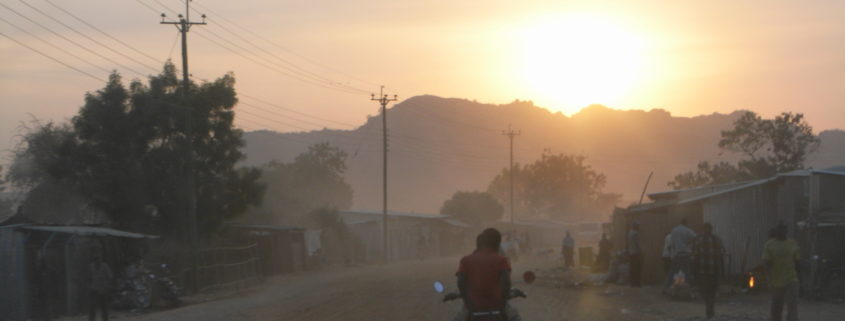This year marks the 30th anniversary of the start of Operation Lifeline Sudan (OLS) and the start of the modern period of aid provision in South Sudan. This landmark humanitarian relief response was built around a ground-breaking agreement between the Government of Sudan, the SPLM/A, and the United Nations, and was instrumental in saving countless lives – it also set into place some of the patterns of interaction between international aid and the context that still resonate today. Decisions taken during this period about how, and with whom, the aid sector works left a lasting imprint on the nature of power and governance, and the economy.
The year 2050 is now just over another 30 years away – and may seem impossibly distant to some – but we can be sure that aid decisions taken today will similarly have long-term impacts on South Sudan’s future prospects. With an annual budget of more than $1 billion USD, the aid sector has an outsized footprint on South Sudan’s economy, job market, and even on the way that power works – often in ways that aid actors do not fully understand. Indeed, one of the most common complaints that the CSRF has heard from aid actors is that they do not have enough time to reflect on the long-term trends underway around us, and how our work interacts with them.
For the past few months, the CSRF has been leading conversations with university students, NGOs, South Sudanese civil society, donors, and academics about what we can learn from the past 30 years, what the year 2050 might bring for South Sudan, and what the legacy of aid will – or should – be by then. Two tiers of recommendations have so far emerged; one at the systemic level and one at the strategic level:
- Tier 1: The Aid System
The aid system in South Sudan comprises a diverse group of actors with diverse motivations, including donor country politics, international principles and agendas, organisational bottom lines, inertia, and ambition. The following recommendations acknowledge the ambition implied, but also recognise the necessity of such aid reforms for a positive legacy by 2050.
Question the goals of the aid system in South Sudan. Participants felt that current short-term approaches to humanitarian aid can perpetuate the need for aid, because the resources provided and approaches used can fuel competition between conflict and political actors, and can entrench unhealthy political and market economies. Likewise, short-term approaches to supporting peace through agreements and stability measures distract us from the longer, more difficult, work of transformative change, and can further entrench existing norms around elite negotiations over power and resources.
Reform the rules of the aid system in South Sudan. Donor policies and procedures for funding and assistance create the rules of the game for their implementing partners – they define success, they create incentives, they prescribe options for decision-making, and proscribe actions and behaviours they seek to limit. While these policies are generally well-meaning in intent, sometimes they interact with local contexts with perverse results. A forthcoming CSRF Policy Brief will explore this in more detail.
- Tier 2: The Strategy of Aid
By 2050, a range of factors will conspire to make the world, and within it East Africa, quite different places than we know today. Population growth, technological change, climate change, and economic developments have the ability to change some of the structural dynamics that currently drive much of what we assume is static about South Sudan’s options and constraints. The CSRF will produce briefing notes about the above topics over the coming year, but discussions with stakeholders thus far have synthesised the existing analysis into the following three strategic recommendations for the aid sector in South Sudan.
Understand our impact on the nature of power, control of resources, and decision-making in South Sudan (within aid programmes and within South Sudanese society). Currently power within the aid sector, like within South Sudanese politics, is exercised in a top-down way. Aid actors have a responsibility to devolve power and decision making within their organisations and away from Juba, with their partners and beneficiaries, and to encourage and find ways to push the government to do the same.
Contribute to South Sudanese skills, strengths, and knowledge to manage challenges and develop positive livelihood, social and political options. These are long-term projects which don’t yield immediate results, but are transformative in the longer-term – both in terms of economic growth as well as political transformation.
Support constructive natural resource management in a context of climate change and high population growth. South Sudan’s annual rainfall has already declined 10-20% and become more unpredictable over the past 40 years. These trends are set to accelerate as temperatures are predicted to increase – particularly in the northern half of the country. Rapid population growth in the region, and demand for farmland and water from South Sudan’s neighbours as well as foreign investors, will lead to more competition for South Sudan’s natural resources, including the incredibly valuable Sudd wetlands. In the absence of accountability, these resources may be auctioned off, undermining the livelihoods and well-being of millions of South Sudanese, as well as the neighbouring countries that benefit from the Sudd’s contribution to regional rainfall.
The level of ambition implicit in these recommendations is extraordinarily high, but also totally necessary to break free from the ongoing cycles of conflict and need. We hope you’ll stay involved in these discussions, and help to contribute to the development of new ideas of what aid’s legacy in South Sudan should be by 2050.



